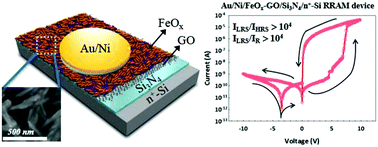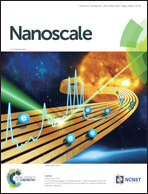Self-rectifying bipolar resistive switching memory based on an iron oxide and graphene oxide hybrid†
Abstract
A resistive random access memory (RRAM) device with self-rectifying I–V characteristics was fabricated by inserting a silicon nitride (Si3N4) layer between the bottom electrode and solution-processed active material of an iron oxide–graphene oxide (FeOx–GO) hybrid. The fabricated Au/Ni/FeOx–GO/Si3N4/n+-Si memory device exhibited an excellent resistive switching ratio and a rectification ratio higher than 104. In the Au/Ni/FeOx–GO/Si3N4/n+-Si device, resistive switching occurs in both the FeOx–GO and Si3N4 layers separately, resulting in a highly uniform and stable switching performance. The resistive switching from a high resistance state to a low resistance state in the Au/Ni/FeOx–GO/Si3N4/n+-Si device occurs through a trap-assisted tunneling process in the Si3N4 layer, enabled by the FeOx–GO layer which prevents diffusion of the migrating Ni metal into the switching nitride layer. The intrinsic self-rectifying characteristics of our memory devices arise from the asymmetric barriers for electrons tunneling into the traps of the Si3N4 layer which is sandwiched between the top and bottom electrodes having dissimilar work functions. Our study confirmed that integrating a suitable dielectric layer into the conventional RRAM cell is an innovative strategy to simplify the architecture and fabrication process to realize self-rectifying crossbar arrays.



 Please wait while we load your content...
Please wait while we load your content...